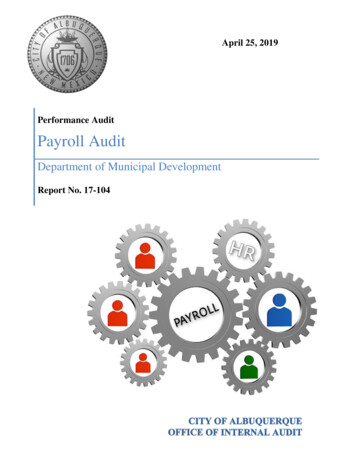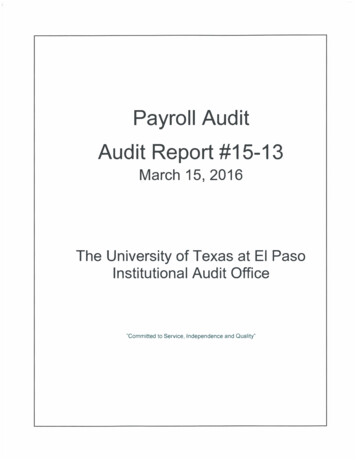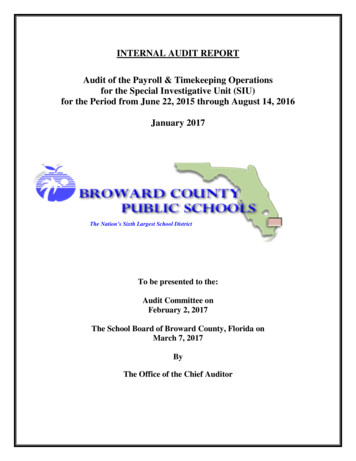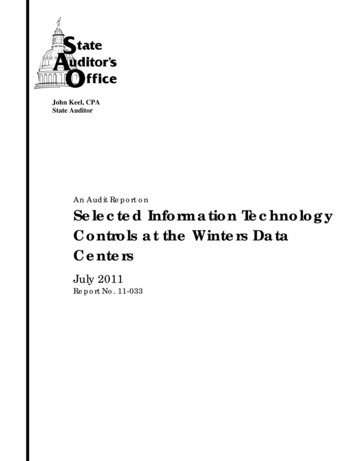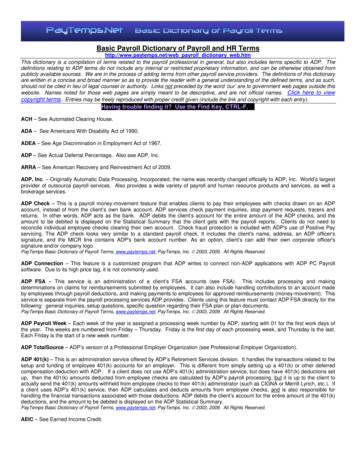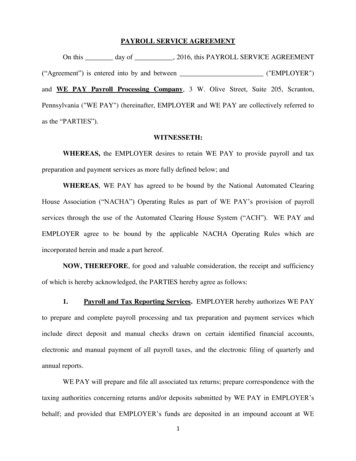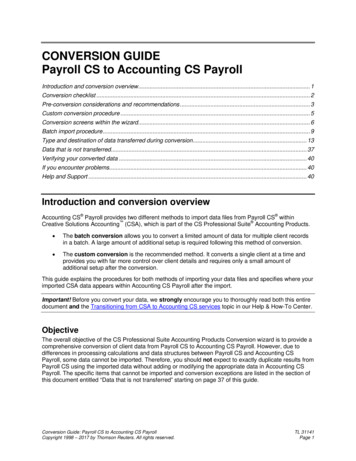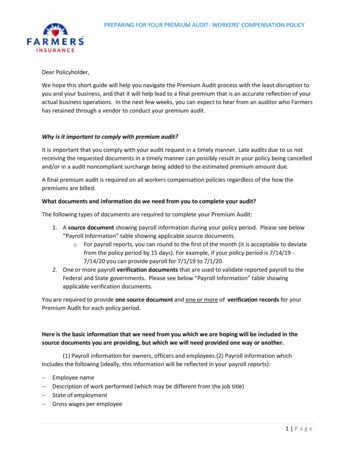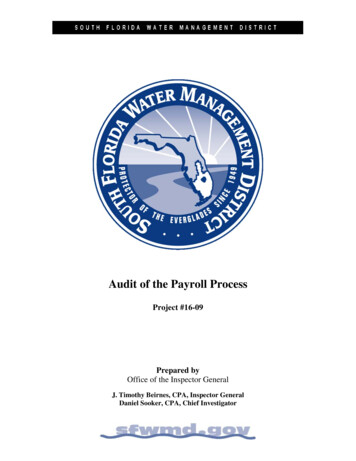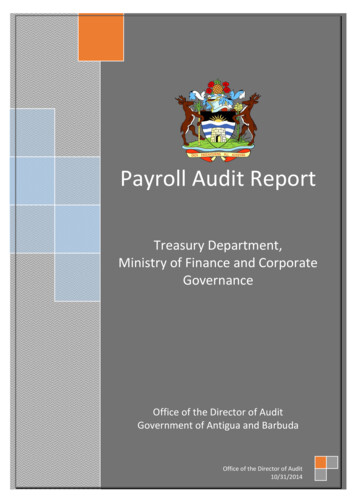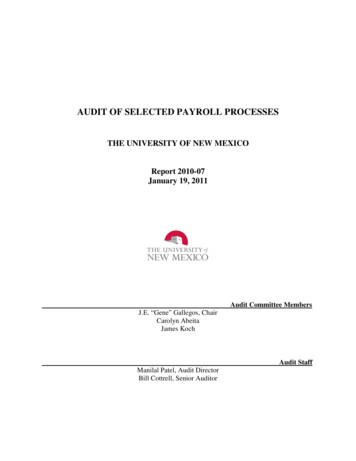
Transcription
AUDIT OF SELECTED PAYROLL PROCESSESTHE UNIVERSITY OF NEW MEXICOReport 2010-07January 19, 2011Audit Committee MembersJ.E. “Gene” Gallegos, ChairCarolyn AbeitaJames KochAudit StaffManilal Patel, Audit DirectorBill Cottrell, Senior Auditor
CONTENTSEXECUTIVE SUMMARY . 1INTRODUCTION. 3BACKGROUND . 3PURPOSE . 3SCOPE . 3AUDIT PROCEDURES . 4OBSERVATIONS, RECOMMENDATIONS AND RESPONSES . 5PAYROLL PROCESSES . 5Analysis of Off-Cycle Payroll Runs and Adjustments . 5Policy for Off-Cycle Payroll Runs and Adjustments. 6EMPLOYEE ACCOUNTS RECEIVABLE . 10EMPLOYMENT DATA CENTERS . 12Consolidation of Employment Data Centers . 13Office of Graduate Studies. 15Faculty Contracts . 15COMMUNICATION AND COORDINATION . 20SINGLE PAYROLL DATE . 23AUTOMATED TIME ENTRY SYSTEMS . 24APPROVALS . 27
ABBREVIATIONSEDCENMUERPFaculty ContractsFTEHRNMHUNMSUNM TechOEOOGSPayrollSACSOMSOM AASOM FCHOSTCUBPUniversityUNMUNMMGEmployment Data CenterEastern New Mexico UniversityEnterprise Resource PlanningFaculty Contracts and Services OfficeFull-Time EquivalentDepartment of Human ResourcesNew Mexico Highlands UniversityNew Mexico State UniversityThe New Mexico Institute for Mining and TechnologyOffice of Equal OpportunityOffice of Graduate StudiesUNM Payroll DepartmentSpecial Administrative ComponentSchool of MedicineSchool of Medicine Academic AffairsSchool of Medicine Faculty Contracts Hiring OfficeSpecial Teaching ComponentUniversity Business Policies and Procedures ManualThe University of New MexicoThe University of New MexicoThe University of New Mexico Medical Group
EXECUTIVE SUMMARYAs part of the fiscal year 2010 audit plan, the Internal Audit Department conducted an audit ofselected payroll processes at The University of New Mexico (UNM). The audit focused oncertain processes in the UNM Payroll Department (Payroll), and how other departments’processes affect Payroll. The main issue affecting Payroll is systemic delays in processingemployment transactions. To compensate for the delays, Payroll has implemented variousprocesses and procedures that divert resources from its regular payroll processing mission. Thefollowing summary provides management with an overview of our recommendations.PAYROLL PROCESSESPayroll spends considerable time and resources processing off-cycle payrolls, adjustments, andemployee accounts receivable. Management should address the causes of the off-cycle payrollsand implement policies to minimize payroll adjustments.EMPLOYEE ACCOUNTS RECEIVABLEEmployee accounts receivable arise when former or current employees receive payrolloverpayments resulting from processing delays for terminations, change in employee status, orchanges in reported time. Payroll spends considerable resources researching, collecting andaccounting for employee overpayments. Management should implement a policy on employeeaccounts receivable and address the delays in processing that give rise to the accounts receivable.EMPLOYMENT DATA CENTERSThe University has seven Employment Data Centers (EDCs) that are responsible for processingthe hiring of University employees. The EDCs each report to different Executive Vice Presidentsand have operations autonomous from Payroll and the Department of Human Resources (HR).Management should consider consolidating the EDCs to streamline the hiring process, and in theinterim, address processing delays in hiring and payroll processing.COORDINATION AND COMMUNICATIONLack of communication among departments and failure to coordinate processes create delays inthe payroll process. Management should enhance communication and coordination in the payrollprocess amongst the Department of Human Resources, Payroll, EDCs, and departmental users ofthe Enterprise Resource Planning (ERP) systems.SINGLE PAYROLL DATEThe University is currently on a dual payday cycle; non-exempt employees are paid biweeklyand exempt employees are paid monthly. Management should explore the possibility of adoptinga single biweekly pay date for all employees.January 19, 2011Audit of Selected Payroll ProcessesReport 2010-07Page 1
EXECUTIVE SUMMARYAUTOMATED TIME ENTRY SYSTEMSThe current time keeping system relies on manual input and is prone to delays and processingerrors. Management should explore the possibility of implementing an automated timekeepingsystem for all University employees.CONCLUSIONAlthough the University has successfully implemented its Enterprise Resource Planning systems,challenges remain in making the system more effective. In an environment of contractedresources, it is more essential than ever that the University find ways to become more efficient.The recommendations in this report are aimed at increasing the effectiveness of currentprocesses, and designing systems and procedures that will improve payroll efficiency.January 19, 2011Audit of Selected Payroll ProcessesReport 2010-07Page 2
INTRODUCTIONBACKGROUNDUNM initiated implementation of the ERP system with Banner Finance in 2004, Banner Studentin 2006, and Banner HR/Payroll in January 2008. UNM implemented the UNMJobs hiring andemployment program and process in 2008.Overall, the University’s ERP implementation has been a success as measured by its ability topay employees and vendors on time, and manage the finances of UNM’s diverse organizationsand operations. The University’s challenge is to continue to achieve greater efficiency ofprocesses and improve on the coordination of all the different components of the ERP system.One of the main challenges to improving efficiency within the ERP system involves improvingcommunication and coordination among operations and departments. The ERP system isintended to integrate the University’s business processes and organizational data so that it ismore consistent, secure, and easier to access by a diverse group of users. One of the underlyingprinciples of ERP Systems is that when ERP software is integrated into the organization toadminister departmental functions, those departments become unified and no longer operateindependently. Business processes at the departmental level affect the entire ERP system, oftenacross organizational lines. Departmental inefficiency can have a domino effect and cause strainon the system in other parts of the organization.The University’s employment processes are facilitated through UNMJobs, while payrollprocessing is facilitated through the Banner HR/Payroll system. The hiring process is complex,requires multiple levels of review and approvals, and requires detailed data entry. In addition,hiring processes differ depending on the type of employee. Payroll is administered throughBanner HR/Payroll, which functions autonomously of UNMJobs. The core offices administeringhiring and payroll transactions are HR, Payroll and the EDCs.Hiring at UNM is decentralized into seven EDCs organized by class of employee. The EDCs arethe offices that are responsible for the hiring process, including employee screening, data entry,and oversight of employment transactions for each specific group of employees. The EDCsinclude: HR-Staff, School of Medicine (SOM) Academic Affairs, SOM Faculty Contracts andHiring Office, Student Employment, Graduate Medical Education, Office of Graduate Studies(OGS), and Faculty Contracts and Services Office (Faculty Contracts).PURPOSEThe purpose of the audit was to assess the payroll processing cycle of the University todetermine opportunities to achieve greater efficiency and effectiveness.SCOPEThe audit focused on certain processes within Payroll and the effect that other departments andcenters are having on these processes. The audit examined the cause of off-cycle payroll runs andJanuary 19, 2011Audit of Selected Payroll ProcessesReport 2010-07Page 3
INTRODUCTIONdelays in processing of employment transactions. Internal Audit completed fieldwork onOctober 25, 2010.AUDIT PROCEDURESAudit procedures included analyzing off-cycle payrolls and payroll adjustments, and interviewsof personnel in the core administrative offices of Payroll, Human Resources and the EmploymentData Centers. We surveyed other New Mexico institutions of higher education regarding theHR/Payroll processes, and also sent survey questionnaires to other peer institutions suggested bythe Provost.January 19, 2011Audit of Selected Payroll ProcessesReport 2010-07Page 4
OBSERVATIONS, RECOMMENDATIONS AND RESPONSESPAYROLL PROCESSESThe Payroll Department processes and distributes salary and wage payments to approximately16,000 faculty, staff and student employees. Additional responsibilities include withholding andremitting employment taxes to the Internal Revenue Service and the State of New Mexico,preparing employment tax reports, and reporting year-end tax information. Payroll is alsoresponsible for: nonresident alien tax status evaluation; tax treaty compliance; insurance vendorpayments; tax deferred annuity enrollment; retirement reporting; enrollment for U.S. SavingsBonds; and, servicing third party garnishments.Payroll employs a total of 15 employees and reports to the Vice President for Finance andUniversity Controller. For FY 2010, Payroll processed a total of 319,085 payments as counted bynumber of direct deposits: 314,281 original payrolls; and, 4,804 adjusted, reissued, voided andmanual payrolls. The total gross payroll for FY 2010 was 835,024,388.Analysis of Off-Cycle Payroll Runs and AdjustmentsPayroll processing through the regularly scheduled payroll cycle is a routine and relativelytrouble-free practice. In addition to the regularly scheduled runs, Payroll also processesnumerous off-cycle payroll runs and adjustments. Off-cycle payroll runs between regularlyscheduled payroll dates are labor intensive, time consuming, and pose a significant stress onPayroll resources.Off-cycle payrolls and adjustments involve research, analysis, calculation and review, andprocessing of direct deposits, all of which allocate resources away from regular Payrollfunctions. Off-cycle payrolls are usually the result of delays in employment paperwork,employees not yet entered into Banner, data entry errors and corrections, and special requests toprocess paychecks. Special requests to process payroll are often the result of delays orbreakdowns in other departments, requiring Payroll to complete the process through off-cycleadjustment.Off-cycle payrolls and adjustments are made either through a Banner adjustment form during acurrent cycle, or by running a payroll adjustment though a subsequent regular payroll cycle.Either method requires additional time and effort to verify correct earnings, payroll deductions,and leave balances. In addition to performing off-cycle payroll runs, Payroll processes time thatis submitted late with a “pick up” run system prior to finalizing the payroll run.Payroll processes non-exempt employees on a biweekly basis and processes exempt employeesonce a month. During FY 2010, Payroll processed approximately 1,500 off-cycle pay checksthrough Banner adjustment forms, and another 900 payrolls via subsequent payroll cycles. Theoff-cycle payrolls were approximately 9/10 of 1% of total payrolls analyzed. Comparably, theState of New Mexico has an off-cycle payroll rate of 1/10 of 1% for all State employees. Acertain level of payroll adjustment is necessary and will always exist; however, the StateJanuary 19, 2011Audit of Selected Payroll ProcessesReport 2010-07Page 5
OBSERVATIONS, RECOMMENDATIONS AND RESPONSESController indicated that the 1/10 of 1% is at the upper level of acceptable strain on Payrollresources for the State. The State of New Mexico processes approximately 624,000 payrolls perfiscal year. All State employees are paid on a biweekly payroll cycle with a one week processingto pay date delay.Analysis of off-cycle payrolls shows that the main cause of payroll adjustment is delay inprocessing employment transactions (See Attachment A). Late processing of transactions orpaperwork occurs for a number of reasons, including: New hires are entered into UNMJobs, but not entered into the Banner payrollsystem;Input of new hires into Banner payroll process prior to finalization of hiringprocess in UNMJobs; and/orDelay in processing terminations, which results in overpayments and employeeaccounts receivable.While not epidemic in proportion, the late paperwork problem does indicate inefficiency inprocessing. The analysis indicated that the delays originate at the department level and occuracross the University. Furthermore, departments where delays occur appear to be concentratedin Faculty Contracts, Office of Graduate Studies, and Human Resources EDCs.The EDCs appear to be ineffective in holding departments accountable for meeting deadlines. Inaddition, they have not been providing guidance and setting policy for departments to follow.The EDCs do not have authority to change department processing procedures. UNM also lacks aUniversity-wide policy on off-cycle payrolls and adjustments.Policy for Off-Cycle Payroll Runs and AdjustmentsThe standard operating procedure at Payroll is to process all requests for off-cycle payrolls andadjustments. University leadership has established a precedent over time – deans, directors andadministrators request that Payroll process off-cycle payrolls for various reasons.Understandably, Management does not want to delay employee paychecks when the departmentmay be at fault. However, exceptions have now turned into standard operating procedures,putting undue stress on Payroll resources. Continual off-cycle processing leaves Payroll in areactive mode, requiring additional resources for adjustments and off-cycle payrolls.Our survey of other institutions of higher education in New Mexico (Attachment B), as well asan inquiry of the State of New Mexico Department of Finance, indicate that it is commonpractice to have one off-cycle payroll run. UNM has a practice of daily off-cycle paycheckprocessing, sometimes occurring multiple times per day.Increasing efficiency in Payroll will necessitate curtailing the off-cycle payroll processing. Thisapproach may result in delay for some employee’s paychecks until the delays at the departmentJanuary 19, 2011Audit of Selected Payroll ProcessesReport 2010-07Page 6
OBSERVATIONS, RECOMMENDATIONS AND RESPONSESlevel are addressed and corrected. The aim is to bring a greater degree of accountability to thedepartments for their processes, rather than pass the consequences for processing delays on toPayroll.Recommendation 1The EVP for Administration should implement policies to end special exceptions and thecontinual processing of off-cycle payrolls and adjustments. To help reduce exceptions, theadministration should implement initiatives to hold employees, supervisors and departmentheads accountable for delays and responsible for their lack of attention.Response from the EVP for AdministrationThe EVP for Administration agrees with the need to reduce the continual process of off-cyclepayrolls and adjustments and reduce the number of exceptions, but does not endorse therecommendation to end special exceptions. In an operation as diverse and expansive as UNMthere is a need for flexibility in order to respond to enrollment changes and researchopportunities, and some special exceptions and off-cycle payrolls are necessary. The EVPproposes the following action to reduce the number of exceptions and off-cycle payrolls:Action ItemsCorrective Action PlannedAssigned toTargetCompletionDate1. Revise Policy 2000 “Responsibility andAccountability for University Information andTransactions” to incorporate accountability for timelysubmission of accurate payroll-related information.UNM Policy Office6/1/112. Payroll will review and evaluate off-cycle payrollsand create a schedule that reduces the number of offcycle payrolls while still ensuring that employees arepaid within a reasonable time. These changes will beadequately communicated to supervisors anddepartment heads to ensure they meet the newschedules.Payroll5/15/113. Human Resources will develop a monthly summaryreport for deans and directors advising them of actionsfrom their units that result in off-cycle payrolls so theycan address the root causes.Human Resources7/1/11January 19, 2011Audit of Selected Payroll ProcessesReport 2010-07Page 7
OBSERVATIONS, RECOMMENDATIONS AND RESPONSESRecommendation 2Payroll should develop a plan to communicate changes in policy to the UNM payroll communityand provide guidance for departments to help ensure successful implementation of new policies.A communication campaign well in advance of the policy change will increase chances forsuccessful implementation. Deans, directors, department chairs, and payroll timekeepers andapprovers should be notified several months in advance of the transition through all meansavailable, including updates on the PR and HR website, emails, newsletters, and enhancedtraining.Response from the Vice President for Finance and University ControllerThe Vice President for Finance and University Controller concurs that a communicationcampaign is necessary to notify the campus community of the schedule reflecting a reducednumber of off-cycle payrolls and the need to reduce the number of exceptions. A substantialreduction in processing off-cycle payrolls will be a change in practice and not a change inpolicy, since off-cycle payrolls are processed on an exception basis outside of the publishedpayroll deadlines. The VP for Finance proposes the following action:Action ItemsCorrective Action PlannedThe Financial Services Division will use StandardOperating Procedure SOP FISC-133: Process-ChangeCommunication Guidelines to communicate anyproposed changes in procedures and practicesanticipated by Item 2 of the action plan in response toRecommendation #1.Assigned toVP for FinanceTargetedCompletionDateBegin assoon asactionbegins onItem 2 ofRec #1.Recommendation 3HR should work with payroll and the EDCs to develop standard guidelines and policies fordepartments to follow. The information should include, but not be limited to: terminations andseparations; adjustments; and, deadlines for submission to Payroll for payment. Payroll shoulddisseminate this information to the department deans, directors, chairs, timekeepers andapprover
Jan 19, 2011 · As part of the fiscal year 2010 audit plan, the Internal Audit Department conducted an audit of selected payroll processes at The University of New Mexico (UNM). The audit focused on certain processes in the UNM Payroll Department (Payroll), and how othe
